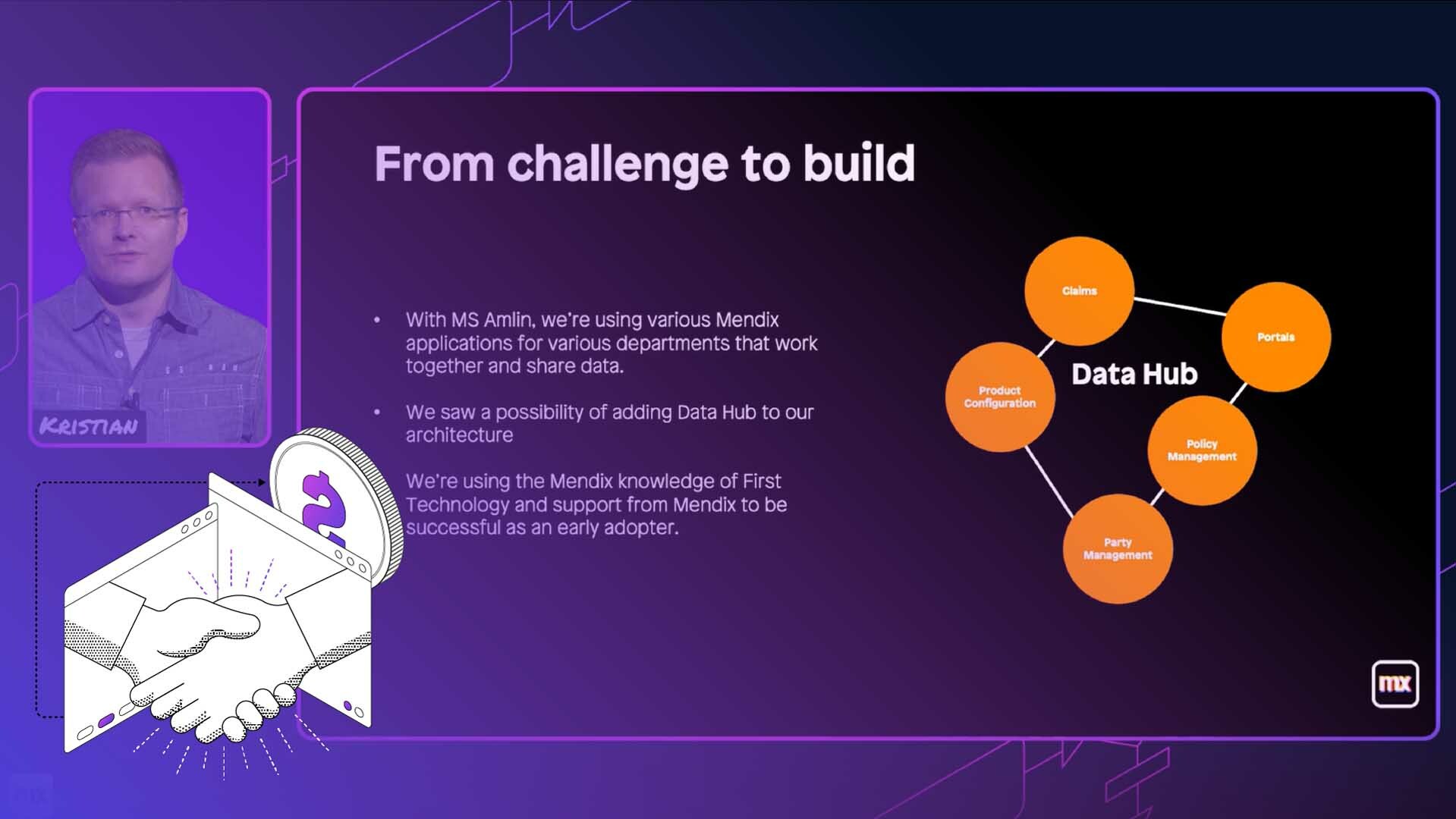Leverage Mendix Data Hub in an End-to-End Insurance Solution

MS Amlin is one of the top brands in European specialty insurance. With 300 years of history delivering top-level service to customers operating in complex and demanding markets, MS Amlin is extremely well-regarded in the Lloyd’s, UK, and Continental European markets.
MS Amlin is facing challenges of increasing complexity in regulations, customer needs, and technology. As Kristian Wijnen, Digital Product and Solution Manager at MS Amlin, noted, “We’re facing the same challenges as any of our competitors, which are basically facing changing markets, changing distribution models, and will need to adapt to that quickly.”
The company is already building solutions including claims management, underwriting tools, and broker portals with Mendix, and recently started using Mendix Data Hub to help streamline data sharing & reuse.
Wijnen joined Ard Bezemer, Senior Principal Technology Consultant and First Technology, and Andrej Koelewijn, Product Manager, Data Hub, from Mendix at Mendix World 2021 to discuss.
Value through Data Hub
Koelewijn described Mendix Data Hub as a new product that “helps [customers] use the data in their Mendix landscape, find it, discover it, and then simply drag and drop the data that’s available… and use it like it was local data.”
Mendix Data Hub not only improves developer productivity, but it helps organizations to improve their connected ecosystem from end-to-end. More than simply a tool that provides better access to data, Data Hub offers MS Amlin:
- The ability to interpret and use that data
- Additional governance to help them ensure that data is used properly and in service of their goals
- The ability to invite external collaborators to use their Data Hub instance, reducing integration challenges
Agility and Compliance through Data
Because they are a global insurance company, data privacy and security is a huge concern and violating regulations can lead to huge fines and other penalties.
As MS Amlin built a larger portfolio of Mendix applications, they noted that a lot of these applications consumed the same data, or would share data with one another.
While copying data from one tool to another may be prudent in a small portfolio of applications, as it grows, and data comes from varied sources, the process of duplication becomes more complex and less sustainable. MS Amlin was looking for a single source of truth, and, as Wijnen stated, “Data Hub was for us, an interesting solution.”

Building the Hub
MS Amlin partnered with First Technology to evaluate how Mendix Data Hub could work within MS Amlin’s ecosystem.
The team at First Technology used a logical application model as their guide. Bezemer described that a master “product management application is used to configure the policy types, the insert object types, the coverages and insert values that belong to the products.”
This resulting product catalog shares data through Data Hub to separate broker portal, underwriting, and claims management applications, which use a non-Mendix backend system. Data Hub links these applications together, enabling disparate MS Amlin solutions to share information in real time.

MS Amlin uses a domain model which links components together via mapping entities. These can be local and shared within the MS Amlin ecosystem, but can also apply to external entities such as brokers and product configurations. This setup was key to maintain data security and integrity.
Brokers need access to MS Amlin systems to create quotes, but, as Bezemer pointed out, MS Amlin doesn’t want to give a broker “access to other brokers’ client data.” Therefore, the team needed to identify any external brokers coming into the Data Hub-linked broker portal.

To accomplish this, the team developed custom headers that would apply when a broker logs in. “Custom headers are built in a microflow where the credentials of the user…are used,” Bezemer described. This solution ensured that brokers would only see data relevant to their account, rather than all data available within Data Hub.
Another challenge the team faced was app performance. There are thousands of data records accessible via MS Amlin’s Data Hub. Not accounting for that would result in slow usage and a poor user experience. Bezemer noted that “every retrieval of authorization is a REST call,” which can put a strain on the app.
MS Amlin and First Consulting then implemented a best practice that they recommend to any organization using Data Hub:
Taking this approach reduces the volume of data processed during each call, and leads to much better performance within their applications.
A Data-driven Enterprise
For developers, “Data Hub simplifies the reuse of data across multiple applications,” said Bezemer. “It’s easy for developers to understand and read the consumed data because the external entities are defined in a managed way.”
For MS Amlin as a business, these early wins with Data Hub have given them the confidence to continue their use of Data Hub, sharing its benefits throughout their Mendix ecosystem.
“And actually use the data that we have so we can actually help our customers and better define products for our client as well.”
Better, cleaner, easier to use data is growing the value MS Amlin receives from its application portfolio exponentially. “Data definitely helps us…moving into the future as well,” Wijnen stated. “The further we get into building more apps, using more data, we’re definitely going to use more and more.”